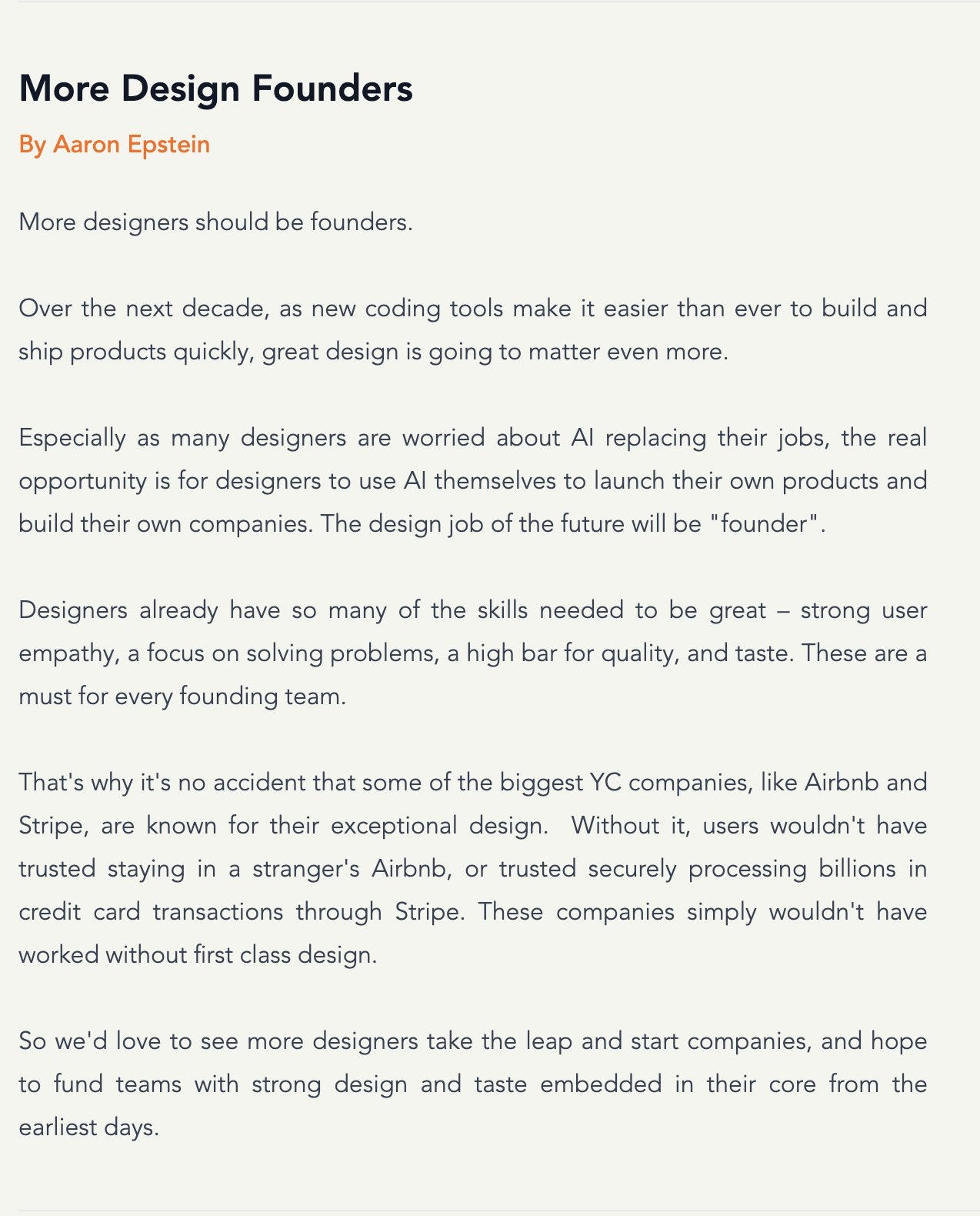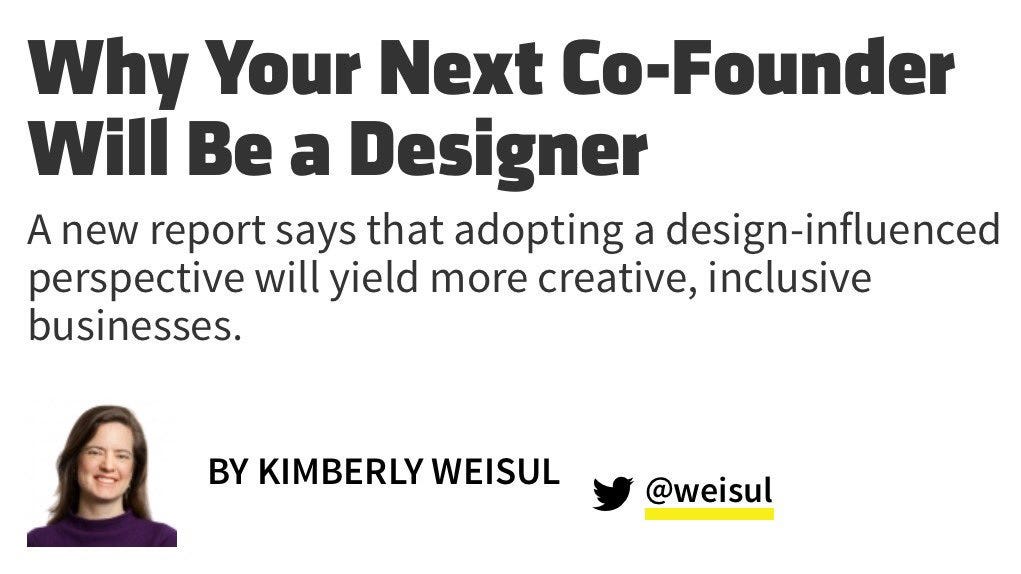More Design Founders
Y Combinator called for it. The rise of designers to founders is now here.
Hey there! This is a 🔒 subscriber-only edition of ADPList’s newsletter 🔒 designed to make you a better designer and leader. Members get access to exceptional leaders' proven strategies, tactics, and wisdom. For more: Get free 1:1 advisory | Become a sponsor | Submit a guest post | 🎁 UX Portfolio Masterclass FREE
Today’s newsletter is brought to you by Atono.
Most tools add complexity. Atono removes it. 😉 If your team is drowning in docs, pings, and context switches—this one’s for you. Learn how reducing cognitive load is the secret to faster, calmer product teams:
“As AI tools make coding easier, great design and taste matter more than ever. That’s why more designers should become founders. Don’t just design products – create companies.” - Aaron Epstein, GP at Y Combinator
Friends,
A few weeks ago, I spoke to a designer who left a senior role at a big-name tech company - great pay, a great team, dream projects. (Btw he had just soft-launched his second micro-SaaS product on X).
When I asked him to explain to me a bit about his decision to leave the company & start something on his own, he told me he was tired, not of designing, but of defending design.
“I didn’t want to keep explaining why good design matters. I wanted to make something where the design spoke for itself — where it was the product.”
That conversation isn’t a one-off. In the past few months, I’ve heard that sentiment echoed repeatedly. In DMs, forums, podcasts, and most visibly, in the number of solo founders shipping products with impeccable UX and zero lines of code.
Did you all see the rising trend of designers finding their brands? And they’re doing it faster, leaner, and with more creative control than ever before.
According to data from Framer, the number of solo designers launching public websites has tripled since mid-2023. Webflow reported a 40% year-over-year increase in accounts tagged with “solo creator” or “startup founder” as their role. Even Figma, a tool born to serve design teams, now supports an ecosystem of independent builders monetizing templates, UI kits, and embedded apps.
Meanwhile, on Product Hunt, the top launches of 2025 aren’t coming from YC-backed startups — they’re from indie founders who used Figma, Notion, and Framer to go from idea to MVP in days. In fact, over 38% of Product Hunt’s top 100 launches this year involved at least one designer-founder.
But, the real question is - Why Now?
I tried to do some research to find out what’s inside the heads of designers. I talked to a few of them who went from being just a designer to a design founder to understand the why. Here are a few reasons they pointed out:
Shift in mindset - For years, designers were positioned at the end of the product process: handed specs, expected to polish the interface, maybe push back on UX. In 2025, they’re at the beginning — spotting problems, sketching solutions, validating with real users, and launching fast.
Tooling - Design software has evolved from static canvases to end-to-end launch platforms. AI accelerators, Web3-native communities, and no-code stacks have turned solo builders into teams of one.
Cultural - The creator economy has blurred the lines between influencer, indie hacker, and founder. Designers have started realizing they don’t need permission to build.
This issue is about that transition. About the new path from Figma to founder. About how product-minded designers are redefining what it means to be “creative” in tech.
Here’s something I found on X:
And why (if you’re a designer), founding might just be your next act.
Before we move ahead here are some takeaways, I wanted to share with you:
Takeaway 1: Designer-led startups raise faster and resonate more
Startups with designer co-founders often move faster from idea to MVP to funding.
According to a 2023 First Round Capital report, designer-founded startups raised seed rounds 23% faster than non-designer-led teams.
Products built by designer-founders have 15–30% higher activation rates in their first month (due to better onboarding, UX clarity, and visual polish).
Designer-led MVPs often attract early adopters organically because their UI feels more “finished” even at v1.
——
Takeaway 2: Design roles are stagnating while technical founders grow in influence
In traditional companies, design still reports up the chain—but in startups, design leads.
Only 8% of designers move into executive leadership roles in large orgs (InVision Design Maturity Index, 2022).
At startups, 20% of founding teams now include a designer (up from 7% in 2015).
Yet, most design professionals don’t see a clear upward trajectory beyond “Senior IC” or “Design Manager.”
The rise of design-led startups
Now, being a founder is great, but are we actually seeing results? And if so, what’s working?
Based on InVision, McKinsey, or internal case studies, this is what I found: Design-founded products are outperforming code-first & MBA-led ventures in 2025.
Founders with design backgrounds are launching products that are not only functional, they’re beautiful, intuitive, and deeply human.
And users are noticing!!
According to a 2024 report by InVision, 84% of consumers say that a brand’s design (including product design) is just as important as its functionality when it comes to loyalty. In the same report, products led by design-first founders saw 23% higher user retention in the first 90 days after launch, compared to those led by traditional business or engineering backgrounds.
📌 Key drivers behind the trend:
Designers now have end-to-end control
Tools like Figma, Framer, Webflow, and Notion + AI enable designers to ideate, prototype, test, and even launch full products — without writing code or hiring developers.
→ Result: Faster GTM (Go-To-Market) with higher user satisfaction out of the box.Users judge products visually — fast
A 2024 Google UX report states:“Users form an impression of a product’s credibility in under 50 milliseconds — primarily based on visual design.”
Design-first products win at first glance and retain through superior UX.VCs are actively backing design-led ventures
Platforms like Designer Fund and Backed VC are placing early bets on design-led founders.
→ In 2024, Designer Fund reported a 3.2x increase in applications from solo design founders.Design is now a strategic advantage, not just surface-level
According to the McKinsey Design Index (MDI), companies with top design scores outperformed industry benchmark growth by 2x in revenue and 5x in shareholder returns.
This video by Y Combinator tells how designers already have the essential skills for building great businesses: strong user empathy, problem-solving focus, and high standards for quality.
Take Notion, for example — a product co-founded by a designer. It disrupted the entire productivity space not by adding more features, but by rethinking how workspace tools feel and look. Fewer buttons. More whitespace. More freedom. And a loyal fan base that grew mostly through word-of-mouth and communities, not performance ads.
Or consider Figma itself — now the backbone of the design world. Dylan Field wasn’t an engineer by trade. He came from design. And he built a collaborative tool that feels intuitive because it was shaped by the same people who use it every day.
You can read a bit on how adopting a design-influenced perspective can yield more creative, inclusive businesses:
Launch fast. Learn faster.
When I was talking to the founder, I asked him one thing: “How do you think your work has changed, and what do you like the most about being independent?”
He told me that projects often get stuck in a cycle of perfectionism at big companies. Specs need to be pristine, multiple layers of approval are mandatory, and QA is exhaustive. In contrast, startups operate on speed. The rule of thumb? Launch something rough, get feedback, and refine quickly. Building and shipping a V0, even if it’s ugly, is often the fastest path to insight. You don’t need a perfect product to prove a point—you need real feedback. A scrappy, barely-functioning prototype can reveal more than a polished slide deck ever could.
Ask your community: “Does this solve a real problem for you?” That early feedback is your fuel. It’s what keeps you from wasting weeks polishing something nobody wants.
If you're building your first product as a designer, remember this: launch something small and a little embarrassing. Iterate fast. Your first launch isn’t your final form; it’s your first proof of demand.
How to find your startup idea as a designer?
Now that we have talked about the basics, the question is how to get an idea that can work well?







